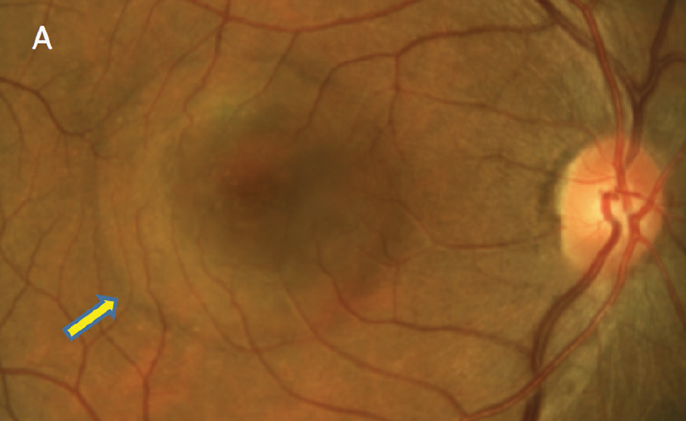 |
CSC has been reported in cases after using varying types of exogenous glucocorticoids, such as with dexamethasone eye drops and inhaled fluticasone. Photo: Mohammad Rafieetary, OD. Click image to enlarge. |
A new report appearing in BMC Ophthalmology outlines an individual instance of a man presenting for vision loss in the left eye. Related to his recurrent central serous chorioretinopathy (CSC), the patient’s pigment epithelial detachment (PED) displayed time-dependent recurrence and resolution.
Cortisol is known to play a role in CSC pathogenesis, with the patient having abnormal time-dependent changes in cortisol levels. With this patient at a follow-up, his PED resolved spontaneously while still in the clinic, however recurred the following morning. The same time-dependent changes of his PED were observed in several follow-ups without any intervention needed. Exclusion of possible external factors prompted the deduction that abnormal diurnal variation in cortisol was the main factor affecting his PED.
While the exact pathophysiology of CSC and PED remain unclear, this case is helpful in the understanding of CSC to a certain extent. Cortisol is the most widely studied hormone in association with CSC. A previous meta-analysis has indicated the CSC group had higher serum cortisol levels than the non-CSC group with significant association of serum cortisol levels and CSC risk. Another study indicated higher salivary cortisol concentrations of CSC patients upon awakening, at 30 minutes and 60 minutes after wake than controls, indicative of a stronger cortisol response. However, the difference narrowed throughout the day and disappeared before 8PM.
CSC has been reported after exogenous glucocorticoid use in the form of oral, inhaled, intranasal, intravenous, intramuscular, intraarticular and periocular administrations. The researchers of the study reason that since low-dose exogenous glucocorticoids can leads to CSC, abnormal endogenous cortisol, a type of glucocorticoid, could lead to the occurrence or recurrence of CSC as well.
Cortisol concentrations typically follow a diurnal pattern, increasing in the second part of the night, peaking in early morning, declining throughout the day and is lowest in the first part of the night. Based on pervious study findings, the authors believe CSC patients’ cortisol levels increase much more than normal during the night. This is what may have led to the patient’s time-dependent recurrence and resolution of PED in this case.
The authors do make sure to mention that “the pathological mechanism of CSC is complex and has not been well understood. Although we have excluded relevant external influencing factors as much as possible, the time-dependent changes of PED observed by us may not be the result under the single influence of the fluctuation of cortisol level.”
However, they do believe that “interventions against the abnormal cortisol level might be a potential treatment strategy for CSC patients. More research is needed to explore the impact of the diurnal change in cortisol levels on eyes with CSC.”
Meng Y, Chen L, Li L, et al. Time-dependent recurrence and resolution of pigment epithelial detachment in central serous chorioretinopathy. BMC Ophthalmol. April 3, 2023. [Epub ahead of print]. |

